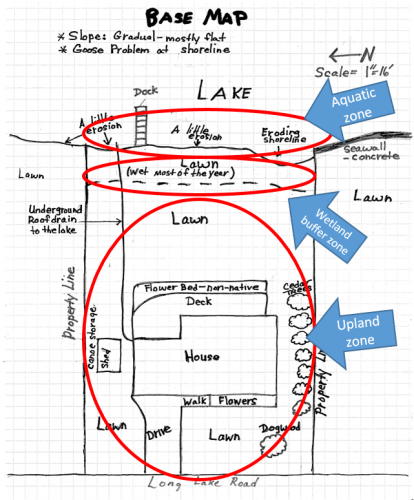Planning natural shoreline landscaping on your inland lake
Through careful planning, lakeshore landscaping can provide both a finished well-manicured look and adequate erosion protection.
Vegetated shorelines have the tendency to resist erosion caused by excessive wave action. Many of our inland lakes have become vulnerable to erosion due to use and development for living and recreation. Rethinking what a shoreline should be is one of the first challenges that a lake property owner encounters. A landscaped shoreline does not have to have appear messy, wild looking to protect the shore from erosion. Landscaping shorelines can take a variety of forms in relation to its repair needs and the homeowner’s desires.
Through careful planning, lakeshore landscaping can provide both a finished well-manicured look and adequate erosion protection. In fact, any property owner can benefit from the same process for planning to improve their landscape. It is important to note that there are a few considerations before you can begin. These serve to identifying limitations and minimize challenges later. Things to think about prior to beginning your project include careful consideration of financial (what is in your budget), physical (what are you able to accomplish on your own), personal knowledge of and where to find plants, and accessible sources for help if needed. You will also need to understand the different shoreline growing zones that will effect plant survival (i.e. upland, wetland, and aquatic zones).

Sample of a simple lakeshore property base map. | Graphic by Julia Kirkwood
Steps for a successful natural shoreline landscape (pdf) are:
- Determine what your needs are by asking yourself some questions. Do you need a place to relax and a place to play? Do you want to encourage fish spawning areas, or just encourage more wildlife? How much lake access do you need? Will you need permits?
- Draw a simple base map of your property. This is called a circle map because it is often generalized using circles. Make sure that you include the house from the road to the shoreline so you can use it to help you with the next step.
- Do a site inventory. What is already present that you can build upon? What has to be removed? Where are there erosion problems or bare spots? Where is the septic and drain field? Is there a seawall on the property? Do you know how much wave energy your shoreline receives? What is your fetch?
- Decide what plants you want and need in each space. Look at and study the plant selections that are suitable for your needs and what are necessary for restoration within the upland, wetland, and aquatic zones. Will you require other materials such as coir logs or riprap to secure the shore from erosion as the plants recolonize those spaces?
- Determine necessary or desired maintenance level. Are you managing a goose problem, as well as restoring your shore? Will you monitor for weeds and invasive species? Is there access to water for regular irrigation until plants are established?
Landscaping for natural shorelines is approached with long-term results in mind. Putting the right plant in the right place, correcting erosion problems, and maintaining the installation all go a long way to having many years of natural shoreline protection combined with our human desire for beautiful landscaped properties.
For more information about the Michigan natural shoreline partnership, Clean Boats, Clean Waters program and aquatic invasive species, contact Beth Clawson, MSU Extension Educator. To learn more about invasive organisms and invasive aquatic plants, contact Michigan State University Extension Natural Resources educators who are working across Michigan to provide aquatic invasive species educational programming and assistance. You can contact an educator through MSU Extension’s Find an Expert search tool using the keywords “Natural Resources Water Quality.”



 Print
Print Email
Email




